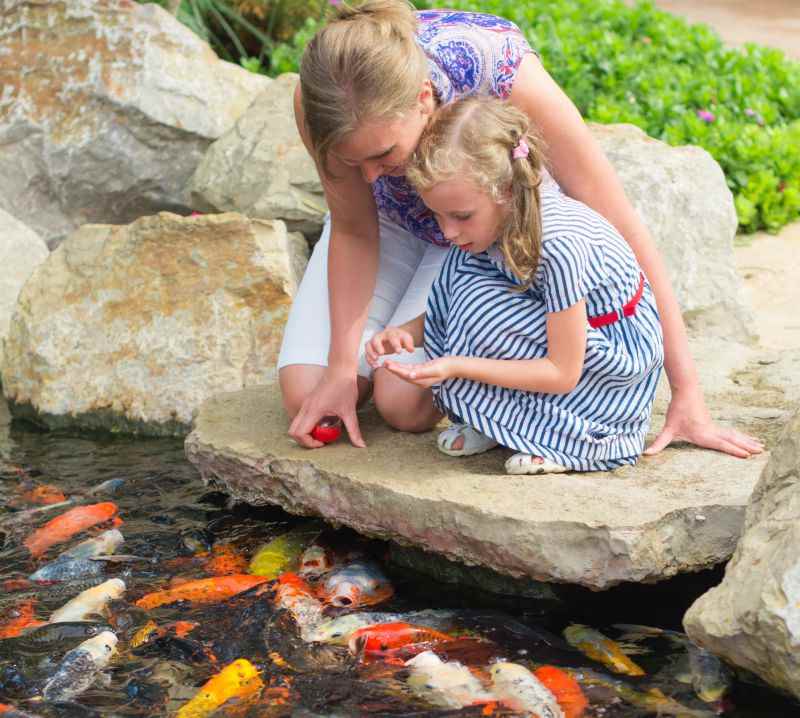In most ponds, you will need to feed your fish. Feeding fish in a heavily stocked pond is essential, such as koi ponds, as any natural food sources will be inadequate to maintain a healthy fish population or build up fishes reserves to see them through the winter months.
A mature pond with a low fish stocking density and a good balance of plants will hopefully have plenty of naturally occurring food sources. Feeding your fish in these ponds acts as a useful supplement as well as giving the pond keeper an enjoyable interaction.
Season, water temperature, fish type and size will determine the correct food type for your fish.
Can I feed my pond fish in the winter: If your pond water temperature is consistently above 5c, and your fish are active, a winter wheatgerm based fish food could be fed. Younger fish will particularly benefit, having not gained the reserves to last the winter.
TIP: Pond water will take a few days to adjust to the ambient air temperature. We would not recommend changing feeding patterns until the water temperature is reasonably consistent with the ambient air temperature.
Early Spring and autumn pond feeding: Feed a good quality staple fish food when your water temperature is constantly above 8c in the spring and autumn. A staple fish food contains a good balance of nutrients and vitamins for your fish as they enter or come out of winter. A staple fish food has a balanced protein level to maintain healthy fish.
TIP: A pond water thermometer is a valuable accessory to monitor the correct seasonal feeding regime for your pond.
Feeding fish in the warmer summer Months: Late spring through to late summer is usually when the water temperature is consistently higher and the fish are most active. This perfect time to feed your fish a high protein growth food helping them grow and gain weight ready for winter..
TIP: Feeding a growth food in the cooler months can cause serious water quality and fish health issues and must be avoided
TOP TIP: Overfeeding fish or using the incorrect food can cause serious water quality and fish health issues. As excess food or fish waste rots, releasing toxins, including ammonia, nitrites, etc. Regular water testing will help you pick up any slight changes in your water quality, allowing you to take preventative action.

In a natural environment, different fish species would feed at different water depths. Tench, for instant, are useful bottom feeders. Koi also naturally feed mainly on the bottom, while golden orfe are surface feeders. However, most fish will take fish food from the water surface in a pond environment, giving the pond keeper enjoyment and interaction with the fish. The natural bottom feeders then pick up any left over fish food that may eventually sinks, helping keep a healthy pond.
Bottom Feeders: In a pond with several bottom feeders, a sinking pellet may be needed, ensuring these species get the diet required to thrive.
Sturgeon and sterlet: Require a unique feed and can be feed all year round, read our in depth guide
Pond pellets come in many sizes to suit most sizes and varieties of pond fish and koi. Available as a wheatgerm, staple, growth or sinking food there is a pellet to suit most fish and seasons.
A popular food type that will float for a long period allowing easy removal of excess food. Stick food is not as manageable for small fish, although they will be able to nibble away at it as it softens. Available as a wheatgerm, staple or growth food to suit all seasons
Flake food is more manageable for babies & smaller fish. However, flake food will quickly become saturated and sink. Care should be taken not to overfeed.
Idea for bottom feeders and a must if keeping sturgeon. Careful feeding is required as it is not easy to assess if you are overfeeding once it has sunk to the depths of the pond.
Sturgeon and sterlet: Require a unique feed, read our in depth guideIn the United Kingdoms climate, feeding once a day should be sufficient in a well-balanced pond with low fish stocking density and plenty of plants as the fish food acts as a supplement to the natural diet available.
More heavily stocked fish ponds with fewer natural food sources will require more regular feeding, maybe 2 or 3 times a day, depending on seasonal conditions and water quality. These ponds should be filtered and water regularly tested to monitor water quality.
Feeding koi and pond fish can often seem complicated; the temperature at different times of the year affects how much they eat and how easily it can be digested. However, when we are asked "what and when do I feed my pond fish?" our experts here at World Of Water are more than happy to share their expertise. Read More